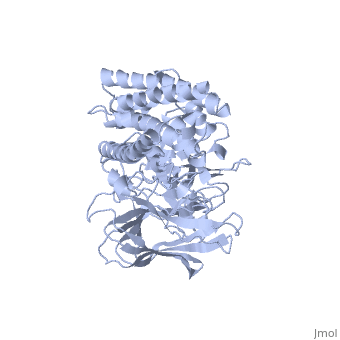Pesticidal crystal protein
Pesticidal crystal proteins (Cry) are endotoxins produced by Bacillus thuringiensis, and form crystal structures (thus the name "cry" proteins, short for crystal). Cry toxins have specific activities against insect species of the orders Lepidoptera (moths and butterflies), Diptera (flies and mosquitoes), Coleoptera (beetles), Hymenoptera (wasps, bees, ants and sawflies) and nematodes. When insects ingest toxin crystals, the alkaline pH of their digestive tract denatures the insoluble crystals, making them soluble and thus amenable to being cut with proteases found in the insect gut, which liberate the cry toxin from the crystal. The Cry toxin is then inserted into the insect gut cell membrane, paralyzing the digestive tract and forming a pore. The insect stops eating and starves to death; live Bt bacteria may also colonize the insect which can contribute to death. See also Toxins. The cry protein has : an alpha helical N terminal domain, domain I; a Greek key beta sheet domain III; and a "jelly roll" antiparallel b-sandwich domain III. The core of the protein is the most highly , with Helix 5 of Domain I and the areas of contact between the domains being the most highly conserved (purple). The insecticidal properties of the Cry protein are associated with domain I, and given the length of the alpha helices and ion conductance data, it is believed that this segment of the protein forms an ion channel. The role of several in Domain I was tested for their role in creating pores in the insect gut membrane via mutation to Ala. Alternation of Arg 233 lead to almost complete loss of the ion channel formation. This residue interacts with , which is in a conserved portion of Domain II. |
| ||||||||||
3D structure of pesticidal crystal protein3D structure of pesticidal crystal protein
Updated on 21-July-2024
1ciy, 6dj4 – BtCry1a – Bacillus thuringiensis
6wpc – BtCry1a (mutant)
7qx4 – BtCry11aa
7qx5, 7qx6, 7qx7 – BtCry11aa (mutant)
4arx – BtCry1ac
4w8j – BtCry1ac (mutant)
4ary – BtCry1ac + GalNAc
7qyd, 7r1e – BtCry11ba
6owk – BtCry1be
6ovb – BtCry1da (mutant)
1i5p – BtCry2aa
4rhz – BtCry23aa1 + BtCry37aa1
4qx0, 4qx1, 4qx2, 4qx3, 6lfp – BtCry3aa
7ear – BtCry3aa (mutant)
1ji6 – BtCry3bb
2c9k – BtCry4aa
1w99 – BtCry4ba
4moa – BtCry4ba (mutant)
4d8m – BtCry5ba
5kud, 5kuc, 5ghe – BtCry6aa
5zi1 – BtCry7cal
